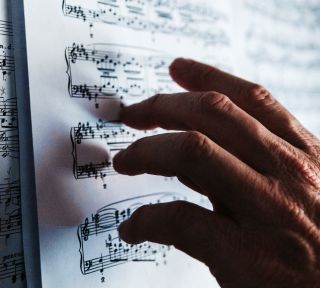Education
Is Reading Fundamental for Performing Musicians?
Research suggests that using notation can be a help and a hindrance.
Posted March 6, 2023 Reviewed by Jessica Schrader
Key points
- Performers who can read music often rely on it to accomplish their most valued aspects of musicianship.
- The use of notation can, however, become a matter of dependence and can even hinder learning other skills.
- Non-readers accomplish much without notation, but know their inability to read makes certain music activities inaccessible to them.
Reading is Fundamental is the oldest and largest American nonprofit organization that exists to promote children's literacy. Empowering and encouraging kids to read is a cause that everybody can get behind, much to the pleasure of educators. Perhaps, in a similar vein, many music teachers prioritize reading music among the learning objectives they have for their students. Occasionally, however, some people have questioned whether this objective has been chosen based on what's best for students, or simply as a function of teachers teaching the way they were taught.

As someone who looks to research to better understand musicians and music phenomena, I have learned to guard against one particular error. Because the vast majority of research is conducted by academics in higher education, usually those people identified as "musicians" in studies are those who developed their musicianship primarily through formal education. And the music performance skills examined in research are usually those that are studied in educational institutions, and are often limited to classical music, and sometimes jazz. In my early days of blogging, I received a few comments from disappointed readers, who had looked to my post for insights only leave disappointed that it described a type of musician quite unlike themselves. Yes, I learned about this source of bias the hard way.
With this background, you'll understand why I was excited to see new research, which studied musicians' perceptions of notation reading, and which intentionally included a disparate sample of musicians. The article, “Musicians’ Views on the Role of Reading Music in Learning, Performance, and Understanding” (Arthurs & Petrini, 2023), appeared in the advance online publications of the journal Musicæ Scientiæ just a few weeks ago. The researchers developed a survey to question musicians’ experiences with and perceptions about music notation. Their sample of participants included musicians who identified as readers and those who were non-readers.
The researchers found that among readers, notation is an important vehicle for accomplishing their most valued aspects of musicianship. They feel that it allows them to perform more music and more varied music, to learn it quickly, and to collaborate with other musicians. I certainly understand this, as a music educator, who sometimes finds himself with a large group of student musicians, charged with the task of quickly coordinating an ensemble performance. However, as any school ensemble director will tell you, the success of this approach—that is, handing out written parts to ensemble members, and then working from the notated conductor score in rehearsal—depends on all the musicians being proficient notation readers. Of course, this is not always the case, even among music students with considerable experience in notation-based ensembles. I will address this issue a bit more below.
The researchers also discovered that readers believe that notation use can be a hindrance to free expression and the development of improvisation skills. I understand this, too, but based on other research I’m familiar with, I would suggest that it is not the ability to read notation that stunts growth in these other areas but exclusive focus on notation-based performance that comes at the expense of other kinds of music-making. In fact, if learned properly, notation reading develops out of the same underlying musical skill as other subskills, such as improvising, memorizing music, and performing music by ear (McPherson & Gabrielsson, 2002).
For their part, non-readers in the research study expressed the feeling that they are able to accomplish their valued musical activities without notation. They did, however, acknowledge that their inability to read can make certain music experiences inaccessible to them. Some of the non-reading musicians considering a career as a professional expressed an interest in learning to read notation, if only to open up career opportunities as studio session musicians or in theatre work (Dean, 2019). I found it interesting that non-reading musicians who had made it to a somewhat advanced level (the point that they’re considering it as a career) would be open to learning an entirely new skill. I would guess that far fewer notation-dependent “classical” musicians express an interest in learning to play by ear or improvise to round out their musicianship, especially if they have managed to reach college-level study without it.
Some music people seem to have no problem dividing all musicians into two categories:
- Readers are not just those who can read music, but they require notation to perform (and usually time practice from the written music; as such, they cannot be expected to do any improvising or music-making by ear.
- Ear musicians are those who are adept at improvisation and learning music through listening, but they cannot read notation at all; so they need not be considered for a performance that will be produced from written sheet music.
The problem with this dichotomy is that, in reality, there are many musicians who are complete performers. That is, they can skillfully sight-read sheet music and offer an improvised solo if a gig requires it and learn by ear from other musicians (co-performers) if it’s the quickest way to add a certain musical feature into their own performance.
When talking with music teachers who accept the above dichotomy, I like to ask them which teaching task they think would be easier: teaching a reader how to play by ear and improvise, or teaching an ear musician how to read notation. They almost always choose the latter. Sometimes I suspect they decide against teaching a reader to improvise and play by ear simply because they themselves never learned these ear-based skills, and may even believe that they result from innate talent and “can’t be taught.” Indeed, I have noticed that many musicians like to blame talent (that they did not receive) for any musical skill deficiencies that they may have.
Regardless, they are correct that it is easier to teach a good-ear musician to read notation. In fact, solid ear-based music-making ability is a prerequisite for learning to read music notation—at least to reading it correctly. In addition to research that indicates this, many historically significant music educators and pedagogues have advanced this principle (Woody, 2012). Among them are Shinichi Suzuki, whose teaching method is known as the “mother-tongue approach” because it prescribes music learning experiences in the same sequence that children learn to speak their native language, and Edwin Gordon, who asserted that “audiation is to music what thought is to language.” These and other language analogies indicate that music students should first listen to music, then imitate it by ear, then only after gaining a level of ear-based fluency, they can be taught to read the symbols that represent the sounds of language/music.
In other words, the best musicians are complete musicians. And there are plenty of them out there. I work with some at my university—performers who are just as comfortable in a symphonic rehearsal working from notation as they are playing a jazz gig with no written music and no advanced rehearsal. Also, I am sure that those who make a living as studio session musicians can do it all too.
Although musicians who can “do it all” may be rare in some musical circles, they need not be viewed as bizarre. Based on the music as language analogy, if more music learners’ formative experiences occur in the correct sequence, then do-it-all musicians can become as commonplace as language users who can read text and also speak without a written script and even speak impromptu to personally express their feelings.
References
Arthurs, Y., & Petrini, K. (2022). Musicians’ views on the role of reading music in learning, performance, and understanding. Musicae Scientiae, DOI: 10.1177/10298649221149110
Dean, J. (2019). The vanishing stave? Considering the value of traditional notation skills in undergraduate popular music performance degrees. In Z. Moir, B. Powell, & G. D. Smith (Eds.), The Bloomsbury handbook of popular music education (pp. 73–80). London: Bloomsbury Academic.
Gordon, E. E. (1999). All about audiation and music aptitudes. Music Educators Journal, 86(2), 41-44.Gordon, E. E. (1999). All about audiation and music aptitudes. Music Educators Journal, 86(2), 41-44.
McPherson, G. E., & Gabrielsson, A. (2002). From sound to sign. In R. Parncutt & G. E. McPherson (Eds.), The science and psychology of music performance: Creative strategies for teaching and learning (pp. 99-115). New York: Oxford University Press.
Woody, R. H. (2012). Playing by ear: Foundation or frill? Music Educators Journal, 99(2), 82-88. DOI: 10.1177/0027432112459199




